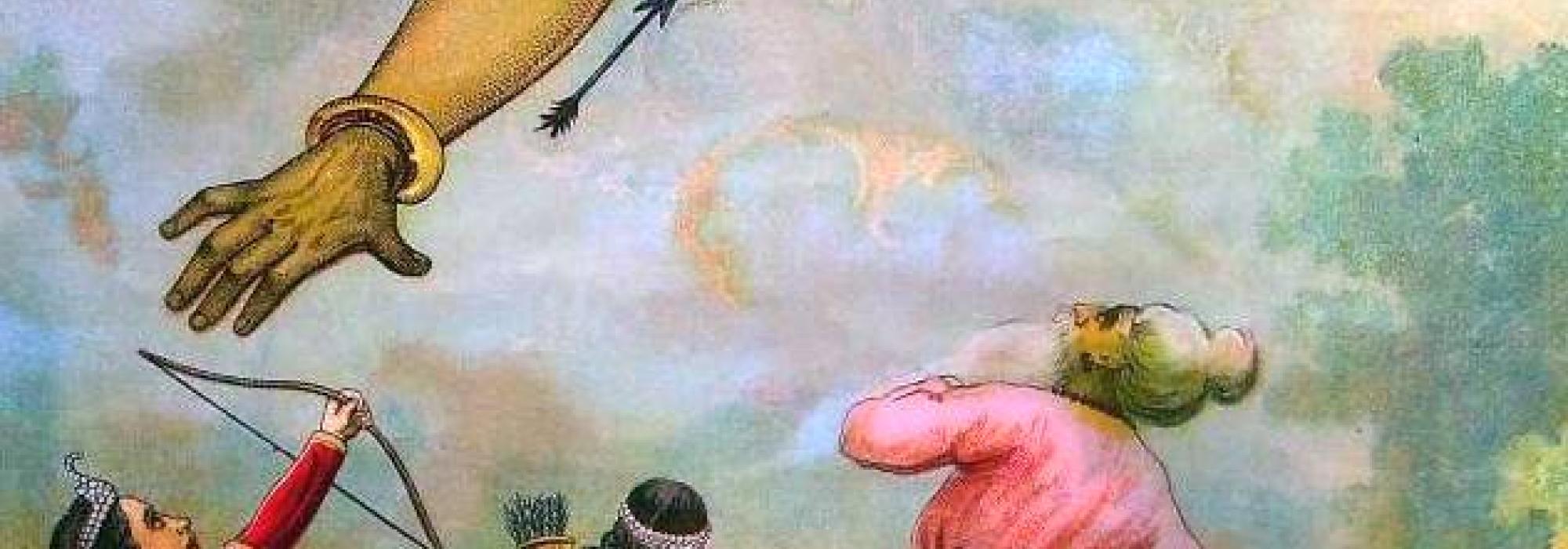The next morning, the brothers woke up, bowed down to the confluence of the rivers Sarayū and Jāhnavī and arrived at the region of Maladā and Karūṣā – the regions that were formed when Brahma-hatyā-doṣa which Indra had acquired upon killing Vṛtrāsura, was washed away. In the region lived a yakṣi named Tāṭakā, the wife of Sunda and the mother of Mārīca. Blessed with the strength of a thousand elephants at birth, she was cursed along with her son by Sage Agastya to become rākṣasas. Viśvāmitra instructed Rāma – “Have no compassion for this woman, Rāma! Vanquish her for the welfare of the four varṇas.” The brothers deduced the presence of the rākṣasī because of her ghastly noises, fought with her, and vanquished her in no time. Extremely delighted, sage Viśvāmitra blessed Rāma with many divine weapons – this included various powerful cakras, maces, vajra, śūla as well as astras including brahmaśiras and brahmāstra. Rāma requested all the divine weapons to be present in his mind and humbly saluted the sage, who also taught him the modes of recalling them.
{Siddhāśrama – The Story of Vāmana}
Rāma and Lakṣmaṇa went ahead with Viśvāmitra and arrived at a beautiful grove. In order to quench Rāma’s curiosity, Viśvāmitra narrated to him the events associated with the place. He said, “This was the āśrama of Vāmana. In the past, Bali, the son of Virocana, defeated Indra and established his own kingdom in the three worlds. The devas, who were subdued by Bali, approached Viṣṇu and told him about a colossal yajña that was being performed by the rākṣasa to make known his power. They requested him to take the form of Vāmana and approach Bali, who had pledged to bestow anything when sought, during the yajña.[1] Heeding to their request and for the welfare of the world, he approached Bali in the form of Vāmana and requested him for three footsteps of the earth. With his steps, he occupied the three worlds and bestowed them back to Indra.[2] Thus, out of my devotion for Vāmana, I have set myself up in this very āśrama. This is the place where the rākṣasas bother us – you must vanquish them!”
As Viśvāmitra and the other sages started performing the yāga, Rāma and Lakṣmaṇa stood watchful for six days and nights without a wink of sleep. On the sixth day when the yāga was close to completion, taking to māyā, Mārīca, Subāhu, and the other rākṣasas started pouring down blood on the yajña-vedī. Wasting no time, Rāma shot the mānavāstra at Mārīca, which threw him into the ocean, a hundred yojanas away. He vanquished Subāhu with the āgneyāstra and the others with the vāyavyāstra. The yāga was thus got completed without any troubles. The sages hailed the brothers and Viśvāmitra declared, “The siddhāśrama has now lived up to its name!”
The next morning, Viśvāmitra said to the brothers – “Janaka, the king of Mithilā is performing a yajña. I am heading there with the other sages. If you come with us, you will see there a marvel, a gem of a bow of immeasurable strength. No being has ever been able to string it.” Excited, Rāma and Lakṣmaṇa went ahead with Viśvāmitra, who was followed by the sages, the birds, and animals of the siddhāśrama. They halted at the bank of the river Śoṇā for the night. A curious Rāma asked Viśvāmitra about the place and the sage started narrating –
{The Story of Viśvāmitra}
“Kuśa, the son of Brahmā had four sons named Kuśāmba, Kuśanābha, Ādhūrtarajas, and Vasu. The father bestowed the kingdom on his powerful sons and each founded a city. O Rāma, the current place is called Vasumatī and was established by Vasu amidst five lofty hills. Kuśanābha, who founded the city of Mahodaya, begot a hundred daughters from Ghṛtācī. In their youth, the beautiful damsels were desired by Vāyu, who promised them a long life if they agreed to unite with him. The maidens ridiculed him and said that they would marry only those men who were approved by their loving father. Angered, Vāyu entered their bodies and deformed their limbs. Now ashamed of their appearance, the maidens went to their father and narrated everything that had transpired. The king was pleased with their forbearance and dhārmic nature. He started looking for worthy grooms for his daughters.
In the meantime, the brahmarṣi Cūlī begot a son called Brahmadatta through Somadā, a gandharvī. Kuśanābha gave his daughters in marriage to Brahmadatta, upon whose touch, the hundred women were freed from their deformity and got back their beauty. With his daughters given away, Kuśanābha performed putrakāmeṣṭi, to beget a son. With time, a son named Gādhi was born to him, who is my father. As I am born to the family of Kuśa, I am Kauśika. I had an elder sister named Satyavatī, a great pativratā, who was married to Ṛcīka. She went to svarga in her corporeal frame following her husband! The magnanimous lady started flowing down the Himālaya as the celestial stream, Kauśikī. I live on her banks and had come to siddhāśrama in order to perform the yajña. I have now fulfilled my vows, thanks to you!”
To be continued...
[The critically constituted text and the critical edition published by the Oriental Institute, Vadodara is the primary source. In addition, the Kannada rendering of the epic by Mahāmahopādhyāya Sri. N. Ranganatha Sharma and the English translation by Sri. N. Raghunathan have been referred.]
[1] Some editions of the epic also say that Kaśyapa and his wife Aditi performed tapas to Mahāviṣṇu, who upon their request, was born to the couple in the form of Vāmana.
[2] The popular version of the tale tells us that Viṣṇu, in his form as Trivikrama, scaled the entire earth with his first foot step, the skies with the second, and pushed down Bali to pātāla-loka, with the third.














































